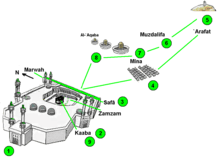Safa and Marwa
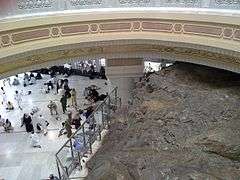
Safa (Arabic: الصّفا, translit. Aṣ-Ṣafā) and Marwa (Arabic: المروة, translit. Al-Marwah) are two small hills now located in the Great Mosque of Mecca in Saudi Arabia named the Masjid Al-Haram. Muslims travel back and forth between them seven times, during the ritual pilgrimages of Hajj and Umrah.
Location
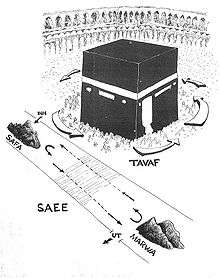
The Great Mosque houses the Ka'bah, the focal point of prayer for all Muslims. Safa—from which the ritual walking or Sa'i begins—and Marwa are located approximately 100 m (330 ft) and 350 m (1,150 ft) from the Ka'bah respectively. The distance between Safa and Marwa is approximately 450 m (1,480 ft), so that seven trips amount to roughly 3.15 km (1.96 mi). The two points and the path between them are now inside a long gallery that forms part of the mosque.The two mounts are still in Mecca for memory of what Hajira and baby Ishmail had sacrificed for water supplies and food supplies.
Islamic tradition
In Islamic tradition, Abraham (Ibrahim) was commanded by God to leave his wife Hagar (Hajar) and their infant son, Ishmael (Isma'il), alone in the desert between Safa and Marwa. When their provisions were exhausted, Hagar went in search of help or water. To make her search easier and faster, she went alone, leaving the infant on the ground. She first climbed the nearest hill, Safa, to look over the surrounding area. When she saw nothing, she then went to the other hill, Marwah, to look around. While Hagar was on either hillside, she was able to see Ishmael and know he was safe. However, when she was in the valley between the hills she was unable to see her son, and would thus run whilst in the valley and walk at a normal pace when on the hillsides. Hagar traveled back and forth between the hills seven times in the scorching heat before returning to her son. When she arrived, she found that a spring had broken forth from where the archangel Gabriel (Jibra'il) hit the ground with his wing as both sustenance and a reward for Hagar's patience. This spring is now known as the Zamzam Well.
Safa and Marwa are mentioned in the following Quranic verse:
Behold! Safa and Marwa are among the Symbols of Allah. So if those who visit the House in the Season or at other times, should compass them round, it is no sin in them. And if any one obeyeth his own impulse to good,- be sure that Allah is He Who recogniseth and knoweth.
Sa'i
Performing the Sa'i (Arabic: سعي, translit. Sa‘ī, lit. 'seeking, search,' or 'ritual walking')[2] serves to commemorate Hagar's search for water for her son and God's mercy in answering prayers. The walkway is entirely covered by a gallery and is divided into four one-way lanes, of which the inner two are reserved for the elderly and disabled.
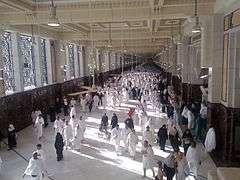 Sa'i towards Safa
Sa'i towards Safa Central section reserved for the elderly and disabled
Central section reserved for the elderly and disabled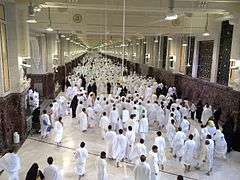 Sa'i returning from Safa
Sa'i returning from Safa
See also
| Wikimedia Commons has media related to Sa'yee. |
References
Coordinates: 21°25′25″N 39°49′38″E / 21.42361°N 39.82722°E
